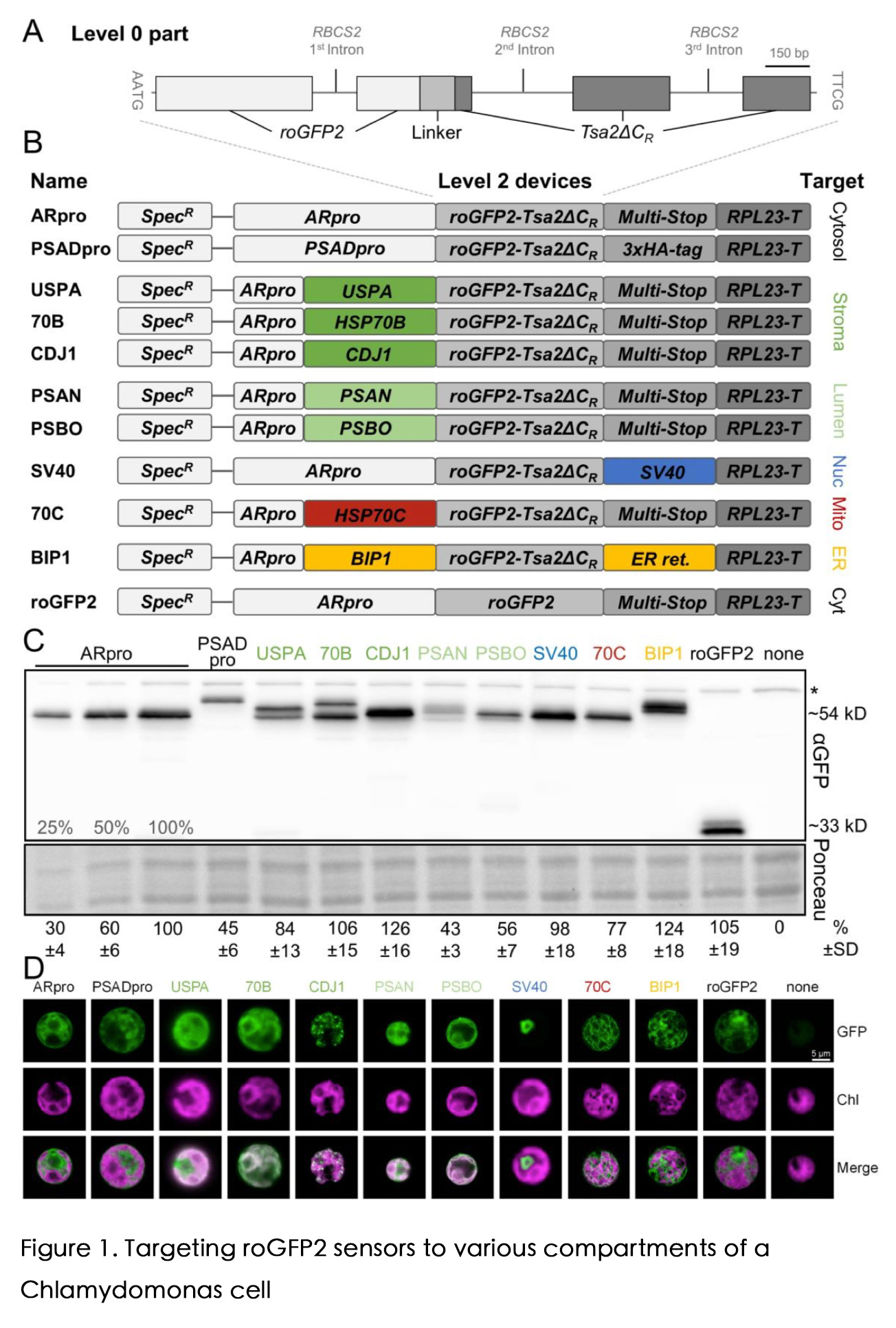博文
Plant Cell:衣藻细胞中实时监控亚细胞水平的过氧化氢波动
||
Real-time Monitoring of Subcellular H2O2 Distribution in Chlamydomonas reinhardtii
第一作者:Justus Niemeyer
第一单位:德国凯泽斯劳滕工业大学
通讯作者:Michael Schroda
Abstract
背景回顾:H2O2 is recognized as an important signaling molecule in plants.
主要研究:We sought to establish a genetically encoded, fluorescent H2O2 sensor that allows H2O2 monitoring in all major subcompartments of a Chlamydomonas cell.
研究方法:To this end, we used the Chlamydomonas Modular Cloning toolbox to target the hypersensitive H2O2 sensor roGFP2-Tsa2ΔCR to the cytosol, nucleus, mitochondrial matrix, chloroplast stroma, thylakoid lumen, and endoplasmic reticulum (ER).
测试结果:The sensor was functional in all compartments, except for the ER where it was fully oxidized.
应用案例-1:Employing our novel sensors, we show that H2O2 produced by photosynthetic linear electron transport (PET) in the stroma leaks into the cytosol but only reaches other subcellular compartments if produced under non-physiological conditions.
应用案例-2:Furthermore, in heat-stressed cells, we show that cytosolic H2O2 levels closely mirror temperature up- and downshifts and are independent from PET. Heat stress led to similar up- and downshifts of H2O2 levels in the nucleus and, more mildly, in mitochondria but not in the chloroplast.
结论:Our results thus suggest the establishment of steep intracellular H2O2 gradients under normal physiological conditions with limited diffusion into other compartments.
展望:We anticipate that these sensors will greatly facilitate future investigations of H2O2 biology in plant cells.

摘 要
过氧化氢是植物中一种重要的信号分子。本文中,作者试图建立一个基因编码的过氧化氢荧光传感器,能够监测衣藻细胞亚隔室中的过氧化氢。为此,作者利用衣藻模块化克隆工具将超敏过氧化氢传感器roGFP2-Tsa2ΔCR靶向细胞质、细胞核、线粒体基质、叶绿体基质、类囊体腔和内质网(ER)。除了ER以外,该传感器在所有的细胞隔室中都能正常工作,在ER中其会被完全氧化。利用这种新型传感器,作者发现基质中光合线性电子传递(PET)产生的过氧化氢会泄漏到细胞质中,但如果在非生理条件下产生的过氧化氢,仅传递到其它亚细胞隔室。此外,在热胁迫的细胞中,作者发现细胞内过氧化氢的水平与温度的上升和下降密切相关,并且独立于PET。热胁迫导致细胞核和线粒体中过氧化氢含量出现类似的上升和下降趋势,但叶绿体中的过氧化氢则没有。因此,本文的研究结果表明,在正常生理条件下,细胞内的过氧化氢具有落差较大的浓度梯度,但并很难扩散到其它的细胞隔室。作者认为这些新型传感器将会极大地促进植物细胞中有关过氧化氢生物学的研究。
通讯作者
** Michael Schroda **
个人简介:
1988-1994年,德国马尔堡大学,学士;
1994-1999年,德国佛雷堡大学,博士;
1999-2001年,法国物理化学生物研究院,博后。
研究方向:植物细胞中的蛋白质稳态。
doi: https://doi.org/10.1093/plcell/koab176
Journal: Plant Cell
Published date: July 01, 2021
https://blog.sciencenet.cn/blog-3158122-1295237.html
上一篇:Trends in Plant Science:STOP1作用于植物胁迫适应的协同和拮抗多效性
下一篇:PNAS:拟南芥开花抑制基因FLC染色质沉默的遗传机制
全部作者的其他最新博文
- • Plant Physiology:CsMADS3促进柑果中的叶绿素降解和类胡萝卜素合成(华中农业大学)
- • Molecular Plant:LBD11-ROS反馈调节作用于拟南芥的维管形成层增殖和次生生长(浦项科技大学)
- • Science Advances:根结线虫通过调控植物的CLE3-CLV1模块,促进侵染进程(日本熊本大学)
- • Nature Communications:油菜素内酯参与植物营养生长期转变的分子机制解析(浙江农林大学)
- • Current Biology:光合作用产生的蔗糖驱动侧根“生物钟”(德国弗莱堡大学)
- • PNAS:花同源异型基因在叶中被抑制、花中被激活的分子机制(南卡罗来纳大学)